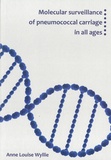Molecular surveillance of pneumococcal carriage in the Netherlands

Wyllie, Anne
- Promoter:
- Prof.dr. E.A.M. (Lieke) Sanders
- Co-promoter:
- Dr. K.P. (Krzysztof) Trzcinski
- Research group:
- Sanders
- Date:
- September 22, 2016
- Time:
- 14:30 h
Summary
While Streptococcus pneumoniae is a frequent coloniser of the upper respiratory tract, colonisation is a pre-requisite for disease manifestations including otitis media, pneumonia and invasive pneumococcal disease (IPD; meningitis, bacteraemia, sepsis). The pneumococcal capsule is its greatest virulence factor with structural differences producing over 90 different capsular types (serotypes). High rates of morbidity and mortality from pneumococcal disease, particularly in infants and elderly, makes S. pneumoniae one of the most clinically-relevant pathogens. Vaccination of infants with conjugated polysaccharide vaccines (PCVs) against pneumococcal disease was introduced in the Netherlands in 2007. Monitoring the vaccine-induced changes to pneumococci in both carriage and disease has been essential in all age groups to assess the direct and indirect (herd) effects of vaccination and when new vaccination strategies are being considered. However, unlike in children, pneumococcal carriage in elderly is rarely detected by the current gold standard method: visual detection following the culture of a nasopharyngeal swab.
Broadly, this thesis aimed at improving the understanding of S. pneumoniae in context of health versus disease. This was in particular reference to asymptomatic pneumococcal carriage and in regards to the vaccination of infants with PCVs. Ultimately, the focus of this thesis was to improve the detection of S. pneumoniae circulating in all ages. Since vaccine-serotype disease was still occurring, we hypothesised that hidden reservoirs of pneumococci existed which the current gold standard detection method was not controlling for. Therefore, we investigated alternative sampling sites in the upper respiratory tract for improved pneumococcal detection. Thereafter, we validated existing molecular methods for pneumococcal detection and serotype determination in polymicrobial samples from the extensive carriage studies already being conducted in the Netherlands. This was a truly unique study setting, where molecular detection was directly compared to the culture-based gold standard, on a large scale.
This thesis first presents a new method for application in both the clinic and surveillances for distinguishing S. pneumoniae from phenotypically similar streptococci which may impede pneumococcal identification. Following, we show that the current gold standard pneumococcal detection method does indeed under-estimate carriage prevalence. This was particularly pronounced in adults and elderly, unveiling a larger than expected reservoir of pneumococci. Additionally, the co-carriage of multiple serotypes was also under-detected by the gold standard in all ages, an important consideration for understanding serotype replacement following vaccine-implementation.
From the expertise gained in our carriage surveillances comparing culture and molecular methods, our findings suggest that the pneumococcal niche changes as people get older. This has important implications for future surveillances on pneumococcal carriage - one single standard for all age groups is insufficient for sensitive pneumococcal detection, namely in adults and those at high risk – the elderly. Therefore, we present new recommendations. For infants, nasopharyngeal swabs remain sufficient but saliva (and oropharyngeal) samples should be collected from older individuals. All samples should be culture-enriched and evaluated by molecular methods for sensitive detection. Furthermore, saliva from all age groups provides a sensitive sample type for longitudinal surveillances and could also be applied for the detection of other bacteria or testing of antibody levels.